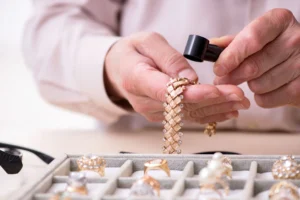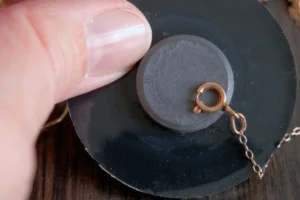Have you ever been lucky enough to inherit a piece of gold jewelry? If and when the time comes, you may find yourself wondering if what you have is the real deal. How can we be sure that gold is authentic?
While at-home gold tests are simple and convenient, they aren’t always definitive. DIY methods like the float test, skin test and magnet test may not account for the other metals that gold alloys contain. Here’s a quick rundown on the most common gold tests.
Keep in Mind: Alloys May Tarnish Test Results
It’s unlikely that the piece of jewelry you’re testing is made of 100% pure gold – 24k jewelry is rare, because gold is too soft on its own to withstand daily wear. With pure gold, even just clanking a bracelet or ring against a hard surface could dent it! However, adding small amounts of other metals like silver or copper to gold-based jewelry can really boost durability.

This is why gold alloys like 22k, 18k and 14k are the most practical choices for jewelry. But the other metals in such alloys may create discrepancies in your at-home test results. For example – iron, nickel and cobalt are magnetic, so any gold jewelry containing these metals might fail the magnet test, even though it still contains real gold.
The methods listed below are great to try as preliminary checks, but they’re not conclusive tests for gold authenticity. If you need to investigate further, you can always head to a professional jeweler for a second opinion. And if you’re simply wondering about gold content for the sake of selling your item, sending it to a refinery is the best way to assess the material and get the highest value for your metal!
Float Test
The simplest of tests: drop your item into a glass of water. If it floats, you definitely have fake gold. If it sinks, it may be real gold. Real gold will sink because it’s denser than water. However, the same is true of other metals like silver, copper, nickel and iron. So if your item sinks, it’s not necessarily real gold – further testing is still needed. But if it floats, you have your answer!
Skin Test
Hold your jewelry between your hands for a few minutes to see if it reacts with your skin. Because gold is non-reactive, real gold shouldn’t create any discoloration. Fake gold, however, could leave green, black, or blue marks behind.


Magnet Test: Use with Caution
The magnet test is often misused, so be skeptical of any jeweler, pawn shop or other business who uses this method to evaluate your items. While the method makes sense for 24k items like bullion, it’s unreliable for testing gold jewelry due to alloys that may include magnetic metals.
Find a strong magnet and hold it next to your item. Gold is not magnetic – so if your object does cling to the magnet, you may either have fake gold or a gold alloy that contains another magnetic metal, such as iron or nickel.
Vinegar Test
Disclaimer: While this method is fun from a science perspective, it can damage jewelry made of gold alloys. Unless you have 24k gold jewelry (unlikely), vinegar can discolor the metal – even with 14k or 18k gold pieces, which still hold significant value. Vinegar testing works best on solid gold items like 24k bullion or raw gold nuggets.
Place your gold into a bowl and add a few drops of vinegar (ideally white vinegar, as it’s most acidic). Real gold will not change color because it’s non-reactive, but fake gold may turn either black or green.
A Second Opinion
If you try a few DIY tests and still aren’t convinced that you have an answer, you could always visit your local jeweler for an appraisal. A professional eye can provide better insight.
A precious metal refinery is another great resource for testing gold. We’ve received our fair share of fake gold at here Garfield Refining – though it’s never the sender’s fault, and we hate to be the bearer of bad news!
To Cash in On Your Gold, Refine It
If you have real gold that you’re looking to sell, sending it to a reputable precious metal refinery like Garfield is your best bet. Unlike pawn shops or cash-for-gold businesses, we’ll melt and assay your items, giving you the most accurate breakdown of the precious metals they contain. Avoid selling your gold to businesses that lack the necessary equipment to determine its true value, because may get far less than what your item is worth.
Remember – Garfield can extract maximum value from your items, ensuring you get paid based on the current spot price of gold (which, by the way, has been soaring lately – gold reached over $2,600 per ounce this month)!
Consider getting cash for gold and selling your gold now –start your shipment today! Established in 1892, we have more than a century of experience in refining precious metals. We serve various industries, including dental offices, private individuals, jewelers, pawnbrokers, and more! Call us today at 888-677-9254 to find out why Garfield is a premier precious metals refinery.
